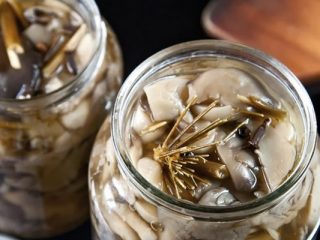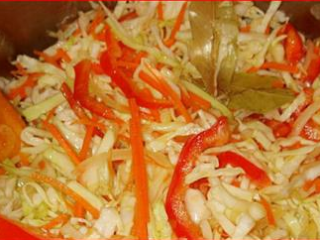Content
Korean dishes are very spicy due to the use of large amounts of red pepper. They flavor soups, snacks, and meat. We may not like it, but we must not forget that Korea is a peninsula with a humid, warm climate, where pepper allows not only to preserve food longer, but also to avoid intestinal infections. It is noteworthy that in the countries located there, the words “delicious” and “spicy” are synonymous.
The savory dishes we love cannot be fully attributed to traditional Korean cuisine. They are prepared with coriander, which is rarely used on the peninsula. This variation was invented by the Koryo-saram - Koreans deported from the Far East at the beginning of the last century, who settled throughout the countries of the former Soviet Union. They simply did not have the opportunity to get the usual products, so they used what was available. Cabbage, pickled in Korean, enjoys deserved popularity among lovers of spicy dishes.
Cooking Korean Cabbage
Previously, only members of the diaspora practiced cooking vegetables in Korean. We bought them at the markets and put them mainly on the festive table, since their price was rather high.But gradually, recipes for Korean pickled cabbage and other vegetables became publicly available. We immediately began not only to make them ourselves, but also to modify them. Housewives today are even busy preparing vegetables in Korean style for the winter.
Kimchi
Without this dish, Korean cuisine is simply unthinkable; in its homeland it is considered the main one. Usually kimchi is Chinese cabbage prepared in a special way, but radishes, cucumbers, eggplants or other vegetables can be used instead. It is believed that this dish helps you lose weight and saves you from colds and hangovers.
Koryo-saram was first made from white cabbage. But we live in the 21st century, you can buy anything in the store, we will prepare kimchi, as it should be, from Beijing. True, we offer you the simplest recipe; if you like it, try a more complex one.
Ingredients
You will need:
- Chinese cabbage – 1.5 kg;
- ground red pepper – 4 tbsp. spoons;
- garlic – 6 cloves;
- salt – 150 g;
- sugar – 1 teaspoon;
- water – 2 l.
It is better to take large cabbage; its most valuable part is the thick middle vein. If you can get Korean red pepper flakes, take it; no, regular ones will do.
Preparation
Chinese cabbage remove spoiled and limp top leaves, rinse, cut lengthwise into 4 pieces. Place in a wide enamel pan or large bowl.
Boil water, add salt, let cool, pour over cabbage. Put pressure on it, let it salt for 10-12 hours.
Combine red pepper and crushed garlic with sugar, add 2-3 tablespoons of water, stir well.
Take out one quarter of Chinese cabbage, coat each leaf with a paste of pepper, sugar and garlic.
Place the spiced piece in a three-liter jar. Do the same with the rest of the parts.
Press down the cabbage well, it should all fit in the jar, pour in the remaining brine.
Close the lid, put it in the refrigerator, take it to the cellar or to the balcony. After 2 days, kimchi can be eaten.
Prepared in this way and completely filled with brine korean cabbage for the winter can be stored until spring.
Korean cabbage with carrots and turmeric
This pickled cabbage is not only delicious, but the turmeric gives it a vibrant yellow color. This recipe is made without ground red pepper and garlic, so it will be spicy but not too spicy.
Ingredients
Take:
- white cabbage – 1 kg;
- carrots – 200 g;
- vegetable oil – 6 tbsp. spoon;
- turmeric – 1 teaspoon.
For the marinade:
- water – 0.5 l;
- sugar – 0.5 cups;
- salt – 1 tbsp. heaped spoon;
- vinegar (9%) – 6 tbsp. spoon;
- cloves – 5 pcs.;
- allspice – 5 pcs.;
- cinnamon – 0.5 sticks.
Preparation
Free the cabbage from the outer leaves, remove all coarse thick veins, cut into triangles, diamonds or squares.
Grate the carrots to prepare Korean vegetables or chop them into small strips.
Combine vegetables, sprinkle with turmeric, pour in vegetable oil, mix well.
Add spices, salt, sugar to the water and boil for 2-3 minutes. Pour in vinegar.
Transfer the vegetables to a smaller container and pour in the boiling marinade.Press down with a weight and put in a warm place for 12 hours.
After 12 hours of marinating, try what happened. If you like the taste, put it in the refrigerator, if not, leave it for another hour or two.
Korean pickled cabbage with beet
There is a fairly large Korean diaspora in Ukraine, many of its representatives are engaged in growing vegetables and preparing salads from them for sale. Table beets are called “buryak” there and are one of the most popular products. We suggest marinating Korean cabbage with it for the winter.
Ingredients
You will need:
- cabbage – 1 kg;
- red beets – 400 g;
- garlic – 5 cloves;
- seasoning for Korean salads – 20 g.
For the marinade:
- water – 1 l;
- salt – 1 tbsp. spoon;
- sugar – 2 tbsp. spoons;
- vegetable oil – 100 ml;
- vinegar – 50 ml.
Nowadays, seasoning for Korean salads is often sold in markets. You can use it to marinate any vegetables.
Preparation
Peel the cabbage from the outer leaves, remove the thickest veins, and cut into squares. Peel the beets, grate them on a Korean vegetable grater or cut them into thin strips.
Combine the vegetables with seasoning and garlic passed through a press, mix well, rub with your hands, set aside while the marinade is prepared.
Boil water with sugar, salt and vegetable oil. Add vinegar.
Pour the hot marinade over the vegetables, press down with a weight and leave in a warm place for 24 hours.
Place the prepared Korean cabbage with beets into jars. Store in a cool place.
Conclusion
As you can see, preparing vegetables in Korean is not difficult.We have provided simple adapted recipes, we hope you will like them. Bon appetit!



















